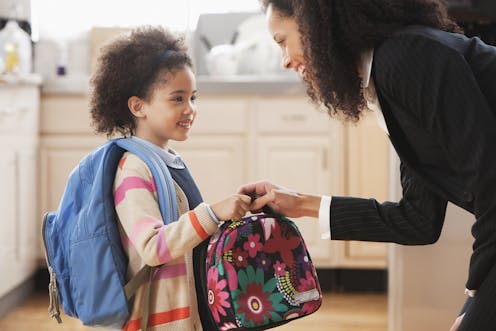
The shift from summer vacation to going back to school can be tough for children and their families. Beyond adjusting to new routines, the transition requires handling a mix of emotions. While some kids might feel excited about new teachers and classmates, others may experience anxiety, sadness or uncertainty about the upcoming school year.
With 15 years of counseling school-age children, I’ve seen how common these stresses can be. I also have three school-age kids of my own. Here are five strategies to make the transition smoother that I not only share with the families I counsel, but that I also apply in my own home.
1. Listen to your child
Listen to your child’s concerns about this transition and validate their feelings. Some children are great at communicating their feelings and talking about them, but others may need to be asked specifically how they feel about the transition back to school. It helps to assure them that most students, even teachers, are experiencing some of the same feelings. Let your child know that it is OK to have a mix of emotions; it is possible to be excited, nervous and sad all at the same time. Research has shown the importance of listening to children, even at a young age, because they are the experts in their own lives.
2. Discuss the new routine
Talk about what the new routine will look like for the whole family. With after-school activities and changing work schedules, it could look a little different each day. Having conversations about the new routine reminds children what the day will look like and will set expectations accordingly.
This takes some of the uncertainty out of the equation, which can be comforting during a time of transition. Research has shown the importance of stability for childhood learning and academic success.
3. Plan ahead
Planning ahead logistically will help your child be prepared mentally for this transition. For example, if it is a new school environment for your child, attend an open house or schedule a tour. Even if the classroom is not open for them to go in, being able to walk into the building will help them to feel more at ease.
Check in with your child to ensure that all their summer reading and assignments are completed so that they will be prepared for their class. If additional academic support will be helpful, have tutoring support lined up.
In order to make the first day run smoothly, have outfits picked out the night before and backpacks packed. This facilitates a smooth morning so that everyone can begin the day on a positive note. When children start the day stressed out and overwhelmed, it can be hard for them to shake that feeling. Research has shown that anxiety can lead to increased time spent awake and poorer sleep for adolescents.
4. Instill confidence
Instill confidence in your child so that they feel empowered and develop a positive sense of self. Ensure that you are talking to your child in a positive manner and highlight their strengths. This helps children to feel more confident about tackling the new school year. Research has shown that students who practice positive self-talk show improved academic performance. Instilling the practice of positive self-talk in children cultivates a mindset that they can overcome challenges at an early age.
Giving your child space to make choices about their self-image – for example, the clothes that they wear and how they style their hair – also helps them to feel empowered and improves self-esteem. High self-esteem directly correlates to future success in life, whether it’s in their relationships, careers or overall functioning.
Taking a step back as a parent can be hard, but it is a natural part of the child-rearing process. I remember struggling when my oldest daughter no longer wanted help doing her hair and wanted to do it all by herself. It was difficult not to step in, but I could see how proud she was of herself for handling this task on her own.
5. Seek support when needed
Change takes time to settle into. If your child is having a difficult time adjusting after three to four weeks have passed, it might be helpful to consider additional support for your child. This could include the school adjustment counselor, guidance counselor or an individual therapist.
From my own clinical experience, I often see a significant increase in referrals in the month of October for children needing services. That’s because October tends to be a good time to assess how your child is doing, after the chaos of transitioning back to school. If you want to seek outside counseling for your child, the school adjustment counselor can provide a list of local resources, or you can also use websites such as Psychology Today and search by ZIP code for local therapists in your area.
Shannon Pickett does not work for, consult, own shares in or receive funding from any company or organization that would benefit from this article, and has disclosed no relevant affiliations beyond their academic appointment.
This article was originally published on The Conversation. Read the original article.







